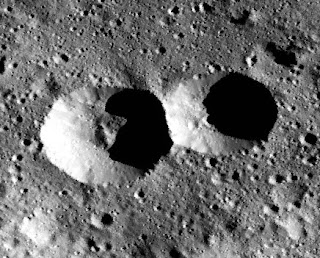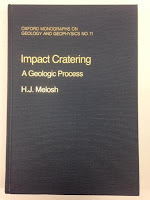A doublet crater is a pair of impact craters in proximity to one another that are created by the same primary impact event. Doublet craters have been observed on Earth, on the Moon, on Mercury, on Venus, and on Mars.
 |
| Doublet crater on Ceres. Dawn image FC0054639 (NASA) |
Doublet crater formation.
Early research attributed doublet crater formation to a single impactor broken up by either atmospheric disruption or tidal forces, but further analysis revealed that these processes could not result in sufficient separation of the components to create observed doublets. It is now believed that well-separated binary asteroids are the true source of doublet craters. The percentage of impact craters in the inner solar system that are doublets would require ~15% of planet-crossing asteroids to be binaries. This makes doublets an excellent source of evidence for the prevalence of binary asteroidal systems, and can constrain the possible nature and formation processes for such binaries.
Binary asteroids.
 |
| Galileo false-color image of asteroid 243 Ida and its satellite Dactyl (NASA image P-44131) |
The existence of satellites orbiting asteroids was considered as early as 1971 based on light curve observations of 624 Hektor. The Galileo spacecraft made the first direct observation of a binary system when it spied a satellite of 243 Ida. Using both ground- and space-based instruments, a total of 290 binary asteroids have been identified in the Earth-crossing, Main Belt, Trojan, and TNO populations.




Comments
Post a Comment